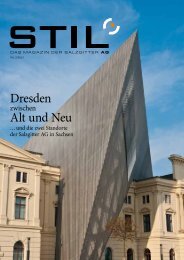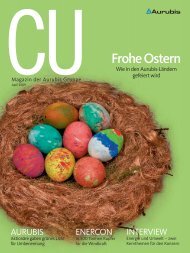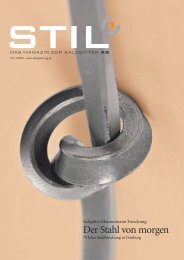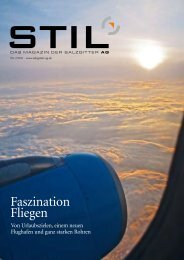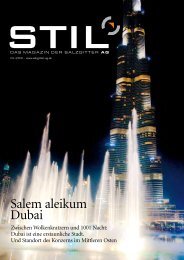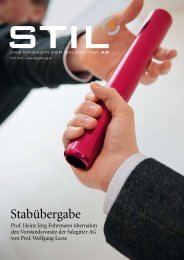Dr. Heinz Jörg Fuhrmann - Schau Verlag Hamburg
Dr. Heinz Jörg Fuhrmann - Schau Verlag Hamburg
Dr. Heinz Jörg Fuhrmann - Schau Verlag Hamburg
Create successful ePaper yourself
Turn your PDF publications into a flip-book with our unique Google optimized e-Paper software.
A keen eye on the future: <strong>Dr</strong>. Wolfgang Leese working out at the Group’s own gym<br />
performance and that of our competitors<br />
whose figures are significantly less impressive.<br />
The reasons for this lies in the measures<br />
I have already referred to as well as the<br />
profitability improvement programs that<br />
have contributed several hundreds of millions<br />
of euros to our bottom line. Management<br />
and a combination of managers and<br />
employees with good ideas, suggestions for<br />
improvement and personal commitment<br />
have also played a substantial part.<br />
stil Salzgitter has taken some important<br />
steps on the path to growth with the acquisition<br />
of precision tubes manufacturer Vallourec<br />
Précision Étirage and a stake of<br />
around 86 percent in plant and equipment<br />
manufacturer Klöckner-Werke. What were<br />
the intentions behind this?<br />
leese Besides the significant world market<br />
Steel<br />
External sales: � 3, 7 billion<br />
positions in different product segments<br />
that these acquisitions have brought us,<br />
we are creating added value for our shareholders.<br />
stil Klöckner-Werke operates in an industry<br />
in which Salzgitter AG has not previously<br />
been involved. What were the objectives for<br />
this commitment?<br />
leese Klöckner-Werke AG forms the nucleus<br />
of our new Technology Division<br />
which offers the prospect of continuous<br />
growth that will in turn have a stabilizing<br />
effect on the Group.<br />
stil Will there be any further growth of this<br />
kind, maybe at the new Technology Division?<br />
leese Certain rounding-off acquisitions<br />
and expansions are currently under consideration<br />
at this division.<br />
Salzgitter Group<br />
External sales cons.: � 10,1 billion Employees: 24 000<br />
Tubes<br />
External sales: � 2, 04 billion<br />
Trading<br />
External sales: � 5,021 billion<br />
PHOTO: PETER LENKE<br />
stil You took up your present post in the<br />
year 2000 with the motto of “independence<br />
through profitability and growth”. How secure<br />
is the Group’s business independence?<br />
leese In the light of our success in recent<br />
years, the firm position of the State government<br />
and the comments made by<br />
Minister President Christian Wulff, our<br />
other stable shareholders and the buyback<br />
of ten percent of our shares, I am less<br />
concerned about our independence.<br />
stil The process of concentration in the steel<br />
industry continues unabated. Salzgitter regards<br />
itself as a niche player. What opportunities<br />
and risks does this position hold?<br />
leese The continuing concentration process<br />
being played out among the dominant<br />
players in the steel industry offers some<br />
outstanding opportunities for us as a<br />
niche player. It is our high-quality products,<br />
our flexibility, our close ties to our<br />
customers and our reliability that set us<br />
apart.<br />
stil Where do your see Salzgitter AG in<br />
three years’ time?<br />
leese We are quite clear on that: We intend<br />
to continuously increase sales to between<br />
13 and 15 billion euros. And over the cycle<br />
we are targeting an ROCE (return on capital<br />
employed) of on average 15 percent.<br />
In addition to that, we also want to enhance<br />
our already positive image.<br />
stil Since you have been Chairman of the<br />
Executive Board, one of your main concerns<br />
has been to increase the willingness at all<br />
levels of hierarchy to embrace change. Are<br />
we fully up to speed by now?<br />
leese We’re moving, but future competition<br />
will make further demands on us<br />
with the result that we must become progressively<br />
faster and fitter.<br />
Services<br />
External sales: � 1,1 billion<br />
Technology<br />
External sales: � 0,5 billion<br />
The History of the Salzgitter Group<br />
Steel and the climate<br />
Steel is part of the solution, not the problem. New materials for the automotive sector<br />
Words like natural resources<br />
and energy efficiency are<br />
on everyone’s lips<br />
nowadays. Hardly a day<br />
passes without climate change featuring<br />
in news broadcasts, talk shows and documentaries.<br />
Only the emphasis varies, from<br />
cutting emission budgets in the context of<br />
CO 2 certificate trading, to missed trends<br />
in the automotive industry or attempts to<br />
ban light bulbs.<br />
The steel industry finds itself squarely involved<br />
in this irreversible process of discussion<br />
and development. On the one hand,<br />
there is the question of the CO 2 released by<br />
our production processes. On the other hand,<br />
however, it is also essential to consider the<br />
contribution that the use of our steels can<br />
make towards increasing our customers’<br />
energy efficiency.<br />
Input materials such as ore and scrap, reduction<br />
agents and energy account for up to<br />
three quarters of the cash cost of steel production<br />
in Germany. For this reason alone,<br />
there is of necessity a sustained economic<br />
pressure at all levels of our undertaking to<br />
conserve resources wherever possible in the<br />
production of steel. For example, iron effi-<br />
ciency has been increased to 0 percent to<br />
date. Similarly, the reduction of around 40<br />
percent since 1 0 in our specific primary energy<br />
consumption per ton of crude steel demonstrates<br />
the successful efforts we have made.<br />
But does this mean that, given the successes<br />
already achieved, the steel industry feels no<br />
further obligation to increase the resource and<br />
energy efficiency of its own production processes?<br />
Indeed not, for at Salzgitter the issue of<br />
efficiency is also an indicator of innovation.<br />
Our continuing achievements in the development<br />
of new materials for the automotive sector<br />
are a prime example. With the production<br />
here in Salzgitter of high- and ultra-highstrength<br />
steels for automotive applications we<br />
are already making a significant contribution<br />
towards protecting the climate. It has been<br />
shown that the development and use of these<br />
steels compensates for a good 15 percent of<br />
the process-dependent non-reducible emissions<br />
during manufacture. This is a great opportunity<br />
for steel products to prove themselves<br />
in the climate debate. Developments in<br />
the field of final-size casting offer the prospect<br />
of new steel grades for the automobile industry<br />
that will allow even greater scope for lightweight<br />
autobody designs. It is becoming very<br />
1923<br />
Foundation<br />
Klöckner Werke AG<br />
clear that in the debate on climate change,<br />
steel as a material is less a part of the problem<br />
than a future-oriented element in the endeavors<br />
by the economy as a whole to increase resource<br />
and energy efficiency.<br />
In future the companies that lead the field<br />
will be those that make most effective use of<br />
their employees’ skills and knowledge, not<br />
least in matters of resource-efficiency. An<br />
analysis of our profitability improvement<br />
program, as well as our employee suggestion<br />
scheme shows that almost a third of the<br />
achievements made concern the consumption<br />
of energy and resources. Climate change<br />
can only be overcome through the knowledge-based<br />
networking of processes and<br />
products. Hysteria and scaremongering will<br />
most certainly not resolve the problem. However,<br />
one-dimensional approaches such as<br />
curtailing highly efficient production as a result<br />
of emissions trading are equally unlikely<br />
to bring us any closer to the desired result.<br />
Making the most of the available opportunities<br />
on a global scale is dependent on deploying<br />
technically intelligent solutions as a helping<br />
hand to enable the developing economies<br />
to use resources and energy efficiently in their<br />
pursuit of growth.<br />
stil stil<br />
1858<br />
Foundation<br />
Ilseder Hütte<br />
1970<br />
Stahlwerke<br />
Peine-Salzgitter AG<br />
1989<br />
Preussag Stahl AG<br />
1998<br />
Salzgitter AG<br />
Steel and<br />
Technology<br />
1937<br />
Foundation<br />
“Reichswerke”<br />
1945<br />
Salzgitter<br />
Hüttenwerk AG<br />
1992/95<br />
Privatization<br />
and Integration<br />
1597<br />
Foundation<br />
Ilsenburger Kupferhammer<br />
1945<br />
Nationalization<br />
since 1946<br />
Production of heavy plate<br />
2000<br />
Acquisition MRW<br />
2007<br />
Acquisition KWAG<br />
1890<br />
Foundation<br />
Mannesmannröhren-<br />
Werke AG (MRW)<br />
1970<br />
Cooperation<br />
Thyssen (steel) /<br />
Mannesmann (tubes)<br />
2000<br />
Takeover by Vodafone<br />
1979<br />
Acquisition<br />
Holstein und Kappert<br />
1994<br />
Divestiture of the steel<br />
production



